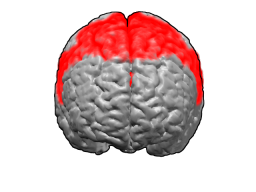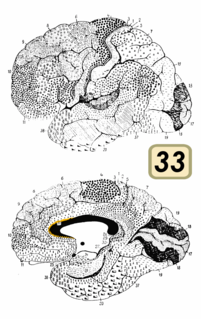It has been suggested that this article be merged with Brodmann area 35 . (Discuss) Proposed since December 2018. |
This article does not cite any sources .(December 2009) (Learn how and when to remove this template message) |
| Brodmann area 36 | |
|---|---|
 | |
 Medial surface of the brain with Brodmann's areas numbered. | |
| Details | |
| Identifiers | |
| Latin | Area ectorhhinalis |
| NeuroLex ID | birnlex_1769 |
| FMA | 68633 |
| Anatomical terms of neuroanatomy | |
Brodmann area 36 is a subdivision of the cytoarchitecturally defined temporal region of cerebral cortex. With its medial boundary corresponding approximately to the rhinal sulcus it is located primarily in the fusiform gyrus. Cytoarchitecturally it is bounded laterally and caudally by the inferior temporal area 20, medially by the perirhinal area 35 and rostrally by the temporopolar area 38 (H) (Brodmann-1909).

Cytoarchitecture, also known as cytoarchitectonics, is the study of the cellular composition of the central nervous system's tissues under the microscope. Cytoarchitectonics is one of the ways to parse the brain, by obtaining sections of the brain using a microtome and staining them with chemical agents which reveal where different neurons are located.

The temporal lobe is involved in processing sensory input into derived meanings for the appropriate retention of visual memory, language comprehension, and emotion association.

The cerebral cortex, also known as the cerebral mantle, is the outer layer of neural tissue of the cerebrum of the brain, in humans and other mammals. It is separated into two cortices, by the longitudinal fissure that divides the cerebrum into the left and right cerebral hemispheres. The two hemispheres are joined beneath the cortex by the corpus callosum. The cerebral cortex is the largest site of neural integration in the central nervous system. It plays a key role in memory, attention, perception, awareness, thought, language, and consciousness.
Together with Brodmann area 35, it comprises the perirhinal cortex.

Brodmann area 35, together with Brodmann area 36, is most frequently referred to as perirhinal cortex.
The Perirhinal cortex is a cortical region in the medial temporal lobe that is made up of Brodmann areas 35 and 36. It receives highly processed sensory information from all sensory regions, and is generally accepted to be an important region for memory. It is bordered caudally by postrhinal cortex or parahippocampal cortex and ventrally and medially by entorhinal cortex.













